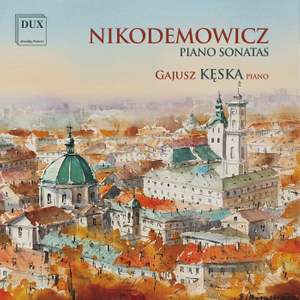This new release from DUX presents Andrzej Nikodemowicz's three Piano Sonatas, performed by pianist Gajusz Keska. Nikodemowicz's three Piano Sonatas Op. 7 (1947), Op. 16 (1951) and Op. 22 (1958), the most expanded of the three, are romantic in their premise, freely narrated and rich in expression. The first two works are in a single movement, while the third follows classical sonata form. The first movement is followed by a Moderato assai, tranquillo, which is an example of a free imitation of opening material, while the last movement, Toccata, is dynamic and distinctive in its thematic flow and form.
Their pianism is a complex and multi-layered phenomenon which goes beyond pure virtuosity, which was never an end in itself for Nikodemowicz. In the 1940s and 50s, his primary goal was to produce a full, saturated and orchestral sound from the piano and to achieve a rich palette of expressive devices. The course that he took was one that was the closest to his imagination and pianistic experience. He employed the entire scale of the instrument, created original textural patterns based on chordal structures and used the possibilities of spectacular leaps across the keyboard and of rich pedalling.
This recording of Nokodemowicz's Piano Sonata is a notable artistic event, a new quality in Polish culture, testifying to the concern for the nation's cultural legacy and the spiritual beauty of music.
Gajusz Keska graduated in 2002 from the Academy of Music in Krakow, where he studied with Andrzej Pikul. He also completed postgraduate studies in the master class of Willem Brons at the Conservatorium van Amsterdam. He has participated in numerous masterclasses given by, among others, Halina Czerny-Stefanska, Paul Badura-Skoda, Pnina Salzman, Emanuel Krasovsky, and Kevin Kenner. His debut album featuring Karol Szymanowski's piano sonatas, released in 2012, received nominations for the Polish recording industry's Fryderyk Prize and for the International Classical Music Award, as well as the award from the Spanish magazine Scherzo.





